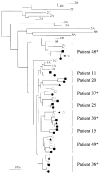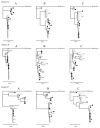Compartmentalization of hepatitis C virus (HCV) during HCV/HIV coinfection
- PMID: 17492592
- PMCID: PMC3210030
- DOI: 10.1086/518251
Compartmentalization of hepatitis C virus (HCV) during HCV/HIV coinfection
Abstract
Extrahepatic replication has important implications for the transmission and treatment of hepatitis C virus (HCV). We analyzed longitudinal HCV diversity in peripheral-blood mononuclear cells (PBMCs) and serum during HCV monoinfection and HCV/HIV coinfection to determine whether distinct amino acid signatures characterized HCV replicating within PBMCs. Analysis of E1-HVR1 sequences demonstrated higher serum genetic distances among HCV/human immunodeficiency virus (HIV)-coinfected persons. Moreover, consensus PBMC sequences were rarely identical to those in the corresponding serum, suggesting divergence in these 2 compartments. Three of 5 HCV/HIV-coinfected participants showed evidence of HCV compartmentalization in PBMCs. Additionally, signature sequence analysis identified PBMC-specific amino acids in all HCV/HIV-coinfected persons. To our knowledge, this is the first study to identify specific amino acids that may distinguish HCV variants replicating in PBMCs. It is provocative to speculate that extrahepatic HCV diversity may be an important determinant of treatment response and thus warrants additional study, particularly during HCV/HIV coinfection.
Conflict of interest statement
Potential conflicts of interest: none reported.
Figures




References
-
- Sherman K, Rouster S, Chung R, Rajicic N. Hepatitis C virus prevalence among patients infected with human immunodeficiency virus: a cross-sectional analysis of the US adult AIDS clinical trials groups. Clin Infect Dis. 2002;34:831–7. - PubMed
-
- Sulkowski M, Thomas D. Hepatitis C in the HIV-infected person. Ann Intern Med. 2003;138:197–207. - PubMed
-
- Perez-Olmeda M, Nunez M, Romero M, et al. Pegylated IFN-alpha2b plus ribavirin as therapy for chronic hepatitis C in HIV-infected patients. AIDS. 2003;17:1023–8. - PubMed
-
- Torriani F, Rodriguez-Torres M, Rockstroh J, et al. Peginterferon alfa-2a plus ribavirin for chronic hepatitis C virus infection in HIV-infected patients. N Engl J Med. 2004;351:438–50. - PubMed
Publication types
MeSH terms
Substances
Associated data
- Actions
- Actions
- Actions
- Actions
- Actions
- Actions
- Actions
- Actions
- Actions
- Actions
- Actions
- Actions
- Actions
- Actions
- Actions
- Actions
- Actions
- Actions
- Actions
- Actions
- Actions
- Actions
- Actions
- Actions
- Actions
- Actions
- Actions
- Actions
- Actions
- Actions
- Actions
- Actions
- Actions
- Actions
- Actions
- Actions
- Actions
Grants and funding
LinkOut - more resources
Full Text Sources
Medical
Molecular Biology Databases

